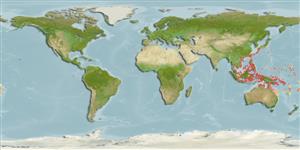Classification / Names
Common names from other countries
Main reference
Size / Weight / Age
Max length : 6.0 cm TL male/unsexed; (Ref. 90102)
Environment
Marine; brackish; demersal; depth range 2 - 10 m (Ref. 90102)
Climate / Range
Subtropical, preferred ?
Distribution
Short description
Dorsal
spines
(total): 6 - 7;
Dorsal
soft rays
(total): 10-11;
Anal
spines: 1;
Anal
soft rays: 9 - 10. Characterized by brown body color; breast and abdomen whitish in color; stripe from eye to upper caudal peduncle, white to yellowish; white stripe below eye to edge of preopercle; second dorsal fin with orange spots; anal fin yellow with brown submarginal stripe; pelvic fins brown; caudal fin yellow with pinkish red streaks (Ref. 90102).
IUCN Red List Status (Ref. 115185)
Threat to humans
Harmless
Human uses
More information
Common namesSynonymsMetabolismPredatorsEcotoxicologyReproductionMaturitySpawningFecundityEggsEgg development
ReferencesAquacultureAquaculture profileStrainsGeneticsAllele frequenciesHeritabilityDiseasesProcessingMass conversion
Tools
Special reports
Download XML
Internet sources
Estimates of some properties based on models
Phylogenetic diversity index
PD50 = 0.5020 many relatives (e.g. carps) 0.5 - 2.0 few relatives (e.g. lungfishes)
Trophic Level
3.2 ±0.3 se; Based on size and trophs of closest relatives
Resilience
High, minimum population doubling time less than 15 months (Preliminary K or Fecundity.)
Vulnerability
Low vulnerability (13 of 100)
Price category
